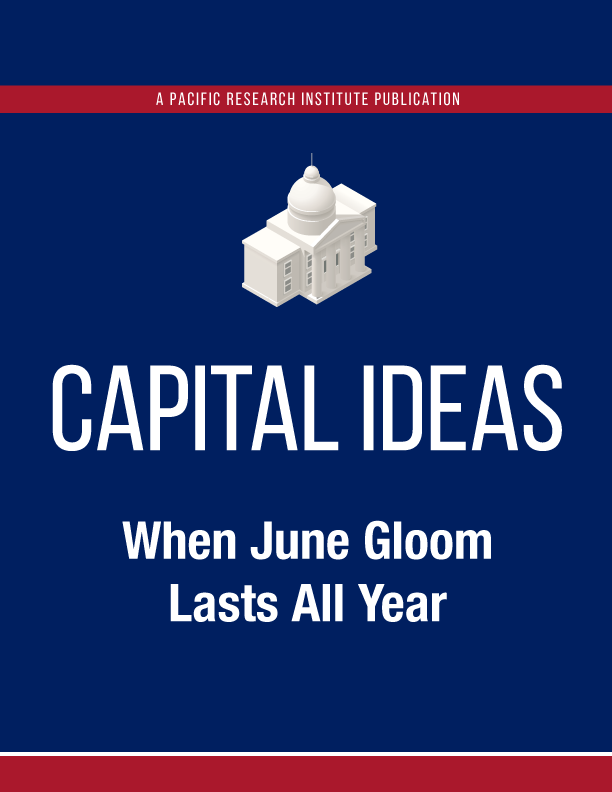The overcast days of June Gloom, a month of cloud and fog cover along the usually sunny Southern California coastal regions, can be a bit depressing. It’s a natural phenomenon that can’t be controlled. The same can’t be said about the man-made darkness ahead that will affect the entire state.
California officials determined years ago that, no matter the cost, the state would go green. By 2045, 100% of electricity must be sourced from renewable energy produced by either wind or solar power. (The policymaker-activists make no room for large hydropower or nuclear – though Gov. Gavin Newsom has indicated that he’s willing to keep the state’s only nuclear plant open beyond its scheduled closing date – both of which are renewable, and consistent in their production.)
As of 2020, only a little more than a third of the state’s electricity was generated by this “magic” power, which will have to replace natural gas, large dams, and nuclear power to keep California running. It will not be a one-for-one swap. The renewables of 2045 and beyond will have to produce more power than natural gas, large hydro, and nuclear produced today. Last year, the California Energy Commission admitted, in what was intended to be an affirming report about the “bold pursuit” of clean energy, that the state “will need to sustain its expansion of clean electricity generation capacity at a record-breaking rate for the next 25 years.”
“On average,” the report continued, “the state may need to build up to six gigawatts (GW) of new renewable and storage resources annually.”
Just two months ago, San Diego Gas & Electric said the road to “decarbonization” requires the state “to quadruple its electricity capacity from 85 GW in 2020 to 356 GW in 2045,” which will include power from green hydrogen, which has to sharply increase from zero to 20 GWs.
Lofty goals. The rest of the blue states and much of Europe would be impressed if California could pull it off. But that’s hardly a given. The hurdles to an all-renewables (which is not the same as carbon-free) electricity grid are considerable.
First, says engineer and energy analyst Ronald Stein, are the “trillions” needed “to turbocharge the clean electricity economy so that it relies solely” on solar and wind.
Stein also mentions the difficulties posed by the “resistance from NIMBYs,” who so far have been successful in “halting those noisy and aesthetically obnoxious wind farms from generating their intermittent electricity.” In his new book Fossil Future, author Alex Epstein says even “passionate advocates” of renewable energy are at times also obstacles that have to be overcome. For instance, “California anti-impact activists” don’t want solar panels placed “in the Colorado desert because of the impact on desert species.”
Energy author and journalist Robert Bryce believes California’s decarbonization goals “have no connection to the physical world,” and “will be ruinously expensive and impose even bigger regressive taxes on residents of a state that already has the highest poverty rate in the country.”
“There’s simply no way the state will be able to quadruple its generation capacity by 2045” when it “can’t add significant generation right now.”
California’s largest county, San Bernardino, which has a greater area than nine states, banned in 2019 large-scale renewable projects, says Bryce, while “numerous wind projects in the state have been rejected,” most recently in February, when the Bureau of Land Management blocked the proposed Walker Ridge Wind Energy Project.
“In fact,” he adds, “California has about the same amount of wind capacity today as it did back in 2015.”
Unless California policymakers stop treating nuclear power as a menace and consider it an acceptable source of renewable energy, the state is going to become America’s blackout central, known more for its energy policy failures than its sun, surf and never-ending good times. Nuclear is clean, reliable, and has a footprint that’s hardly noticeable when compared to the big chunks of land eaten up by solar and wind.
What’s more, nuclear’s land-use advantage will grow even larger if small modular nuclear reactors live up to their promise. Reuters reports they are “cheaper and quicker to build” and “can be shipped by container from the factory and installed relatively quickly on any proposed site.” According to Bryce, the power density of new SMRs built by Rolls-Royce, which are going through the United Kingdom’s regulatory review process, means they “will need 10,000 times less land than a wind project and about 1,000 times less land than what will be required by a solar project.”
The facts should move the renewables crusaders to look at things in a far different light.
Kerry Jackson is a fellow with the Center for California Reform at the Pacific Research Institute.


